Motorsport: Baja 1000 Pre-Run
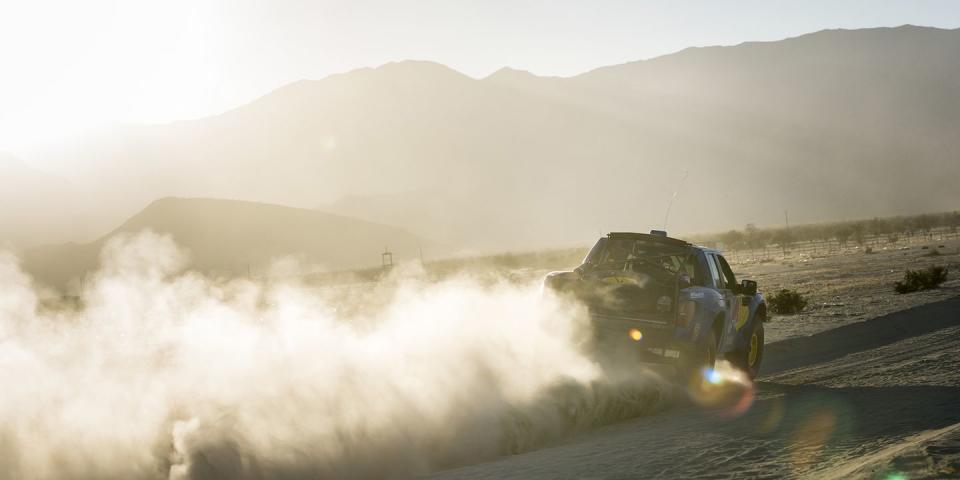
"Do not eat the breakfast tomorrow before the pre-run."
A towering bull shark of a truck rumbled into the parking lot of my hotel in Ensenada, Mexico. Pepe Rodriguez, a Mexican ex-pat and a mechanic for Menzies Motorsports, jumped down from behind the wheel. He pried open the creaking passenger-side door. Inside were two fixed bucket seats up front-one for Bryce Menzies, desert racing’s millennial standout, and the other for his co-driver, Pete Mortensen.
“That is for you,” Rodriguez said, motioning at the central jump seat, a joke of a chair crammed behind the center console. “Can you fit?”
The truck’s cab was lifted from a Ford F-150 and dropped onto a custom chassis, he explained. The door was cut down to three-quarters length, at the expense of rear legroom. The front seating area looked surprisingly civil, with air-conditioning, carpet, two touchscreen GPS displays, power windows, a backup camera, and noise-canceling headphones hooked into an intercom and Sirius radio. The back? Not so much.
I folded myself inside, assuming the position of a human cannonball. The surrounding area was covered in a film of desert grime. It also smelled like the world’s biggest jockstrap.
“This is okay,” Rodriguez said, though it very clearly was not. I slipped into the five-point harness and started adjusting the shoulder belt. “Do not hurt your backbones from making the straps too tight,” he said. “The floor at Baja is hard, and there are many holes to hit. You can jump high.”
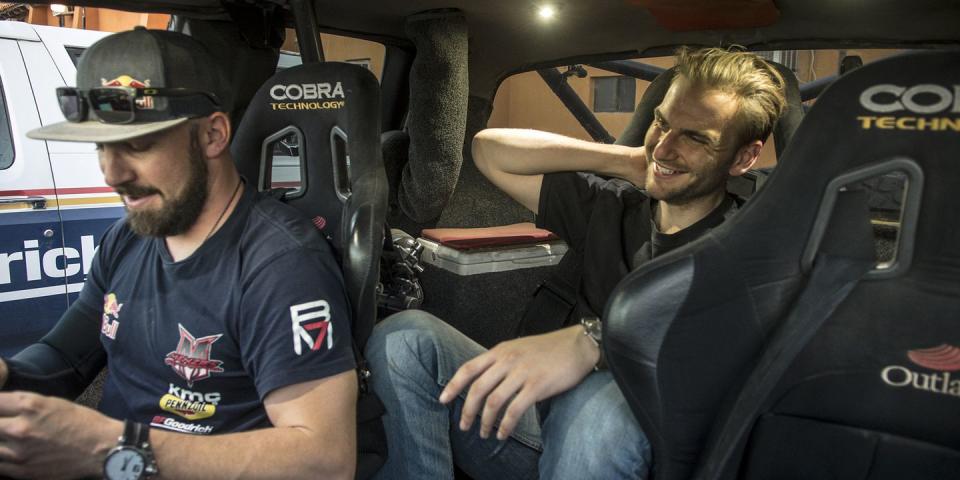
Unlike road racing, where drivers can study a track map, getting the lay of the land in the Baja 1000 requires boots on the ground, partly because the route changes every year. We were to follow a point-to-point configuration, beginning in Ensenada, skirting the Gulf of California, then crossing over to the Pacific side, pinballing around the desert for some 1100 miles, before concluding in La Paz, Mexico. Some sections for 2017 carried over from the 2014 running, the last time the race ended in La Paz, but because topography constantly evolves, it was hardly recognizable.
Whereas many competitors pre-run in buggies, or even modified street trucks, our pre-runner, decked out in Red Bull livery, cost an estimated $650,000 to build. It carries many of the same exotic parts and materials as the trophy truck Menzies would be racing at the SCORE Baja 1000 in two weeks: chrome-moly tube frame, 40-inch BFGoodrich racing tires, fiberglass body panels, and a small-block V-8 with a built automatic gearbox. The trophy truck has a race-gas-fed, 800-hp Chevy engine and a three-speed; the pre-runner, a 650-hp Ford lump, tuned for pump gas and attached to a four-speed. The suspensions are basically identical, with multi-bypass shocks like chrome bazookas inside the wheel wells.
“Maybe do not eat the breakfast tomorrow before the pre-run,” Rodriguez suggested. With an open palm, he pantomimed the truck soaring and crashing to the ground. Then he pointed at my gut. “It will fly out of your food bag.”
There was a language barrier. But the point got across.
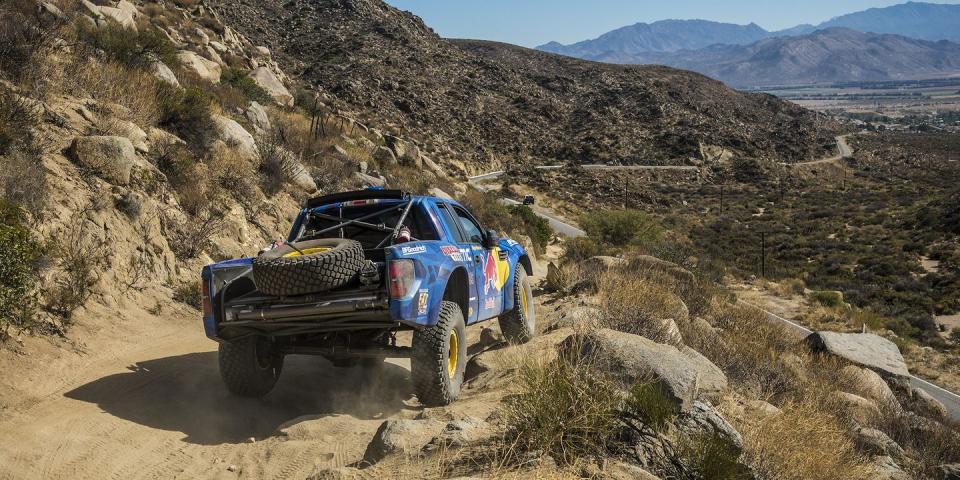
"Maybe we should put you inside a cage."
Menzies and Mortensen went for long stretches, hours sometimes, wordlessly head-bobbing to Top 40 radio on their intercom headsets. We skimmed across dry lakebeds, climbed goat trails, smashed over whoops, waded dunes, all in silence.
A gorgeous section of the course, rolling over enormous dunes and past fishing camps along the shimmering Sea of Cortez, was our stop for lunch-deli sandwiches from the Costco in Ensenada. Menzies unstrapped from the driver’s seat and broke from the group. He paced a few hundred yards, kicking at a dirt dike, eyeballing its trajectory over a two-lane highway.
“Dude, are you thinking about jumping that?” Mortensen yelled. He was lying in the bed of the Ford Raptor support truck, soldiering through a nasty case of food poisoning. “We already have the record,” he said.
If the name Bryce Menzies rings a bell, this is probably why. In 2016, he jumped a Pro 2 race truck 379.4 feet,a new Guinness-certified mark. The stunt, staged at a ghost town outside San Diego, recalled early-day Knievel: uncomplicated, vaguely gladiatorial, and mostly senseless. Which was the entire point. Red Bull produced a slick, bite-sized video and fed it into the viral media machine, helping establish Menzies, then 29 years old, as desert racing’s hip new guard.
He certainly fits the mold. Tall, lanky, boyish, and care-free, Menzies wears skate shorts and Oakley sunglasses. He describes most things in binary verbiage, “awesome” or “sketchy.” Minutes after climbing behind the wheel of the pre-runner, he was staring into the front-facing camera of his iPhone, conspicuously drinking a Red Bull, livestreaming for social media. Unsurprisingly, he hasn’t struggled to find lucrative sponsorship.
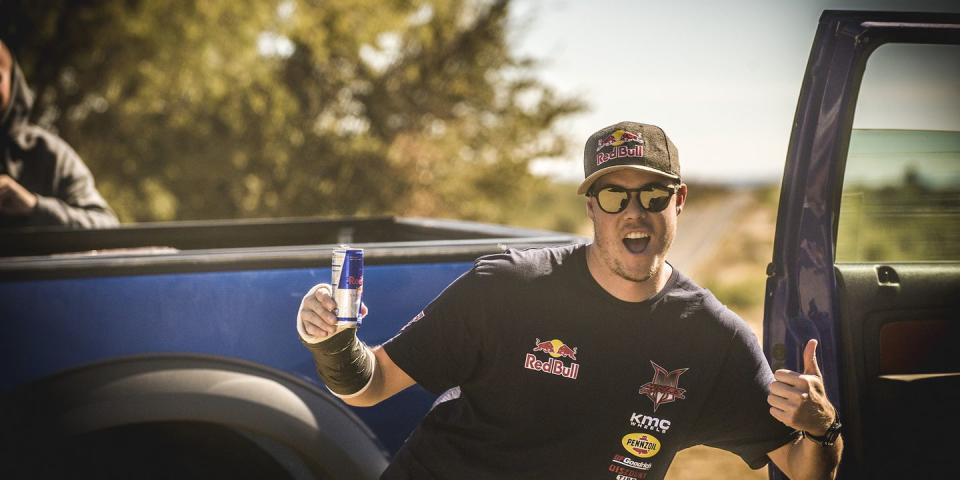
Besides Red Bull, Menzies enjoys backing from BFGoodrich, Pennzoil, and Mini, serving as a factory-backed driver for its rally-raid program. Winning a premier international race, like Dakar, would earn him a seven-figure pay-check. Winning the Baja 1000 pays about $15,000. The bragging rights are worth more.
“I started off racing dirt bikes,” he said. “I got hurt a few times, so my dad [Las Vegas business mogul Steve Menzies] said, ‘Maybe we should put you inside a cage.’ We built a buggy, and I think we finished, like, eighth in our first race, then we won the second race. My dad, he’s all or nothing. He likes going all-in. So we just started buying up semitrailers, shop space, all the stuff.”
Menzies Motorsports was founded in 2008. The team has a dedicated support helicopter and owns the hotel where I stayed in Ensenada. Wealthy privateers and hobbyists aren’t unusual in desert racing. Marc Ewing, founder of software firm Red Hat Inc., spent millions trying to win the Baja 1000. So did reality-television personality Jesse James. Both lost interest and moved on.
But Menzies stuck around. He claimed short-course 0ff-road racing titles in 2007 and 2009, the SCORE series championship in 2011, and overall wins at the Baja 500 in 2011, 2012, and 2014. He told me that between travel, qualifying, pre-running, media obligations, driving for Mini, and moonlighting in global rallycross, he was only spending five days per month at home.
The gap between haves and have-nots on the Baja grid was conspicuous, even during pre-running. Especially romping around in a decked-out Red Bull truck with a full support crew. It was difficult to tell whether Menzies noticed the disparity or was simply having too much fun to care. He dug a toe into the dirt dike, then shouted back to Mortensen. “I don’t know, man. Jumping a highway. It would be pretty f***ing epic.”
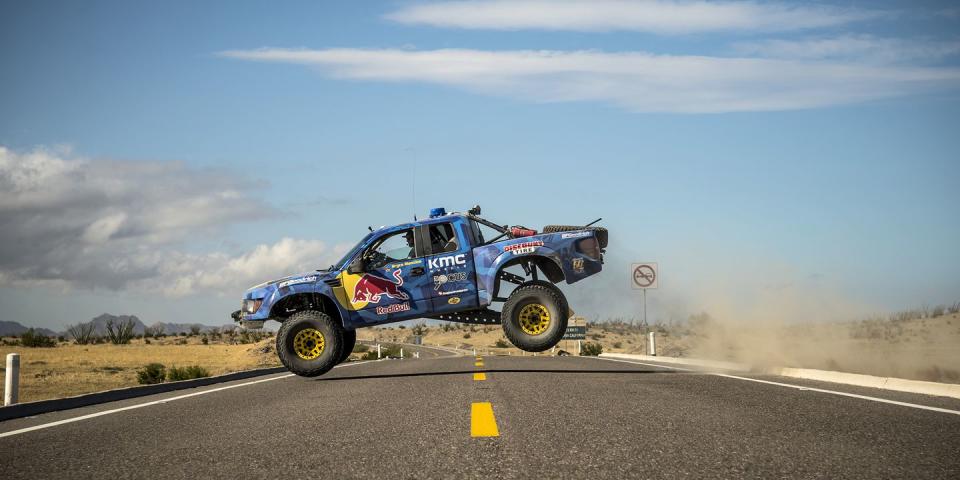
"Airplane means clear-over jump, sky it."
While the Baja 1000 may last 16 to 20 hours, teams spend upwards of a week doing recon. Friends tag along, and there’s time to stop, take in the scenery, indulge local burrito stands. Or sleep off a hangover.
In the north, closer to the border, nightlife picks up as racers stream through. In San Felipe, a once-popular spring-break destination on Baja’s east coast, there were lines outside the bars and clubs, streets drenched in pink and green neon. Gringos ate nachos and sipped Coronas along the main beachside drag; locals carried woven blankets, knockoff sunglasses, and embroidered kitsch, peddling their wares on the sidewalks. The waitress at our restaurant described the wait for food as taking “about three beers’ time.” For co-driver Mortensen, though, pre-running was work.
To understand why-to understand the whole point of pre-running, really-you need to understand the course. It’s little more than a series of virtual markers leading through the desert. SCORE provides a baseline GPS map file, revealing the location of each checkpoint. On race day, the truck gets outfitted with a tracking beacon. It relays info back to race officials, who dole out time penalties for missing checkpoints. In between those markers, the racing is largely free-form. SCORE’s map gives everybody the same blank coloring book. How it gets filled in is up to you. On Menzies’s team, Mortensen was in charge of the coloring.
Throughout our pre-run, he sat in front of the touchscreen, dropping a succession of waypoints and speaking into a handheld audio recorder.
“They go in blank-it’s too bumpy and there’s too much going on to mess with typing on the screen, so I take the details in my voice notes. Then I play them back later and put those notes in and give each [waypoint] a title and an icon.”
At night, while the rest of the Menzies crew watched UFC fights at the hotel bar, Mortensen remained inside the truck, turning the day’s notes into a race map. He pulled up another window on the screen, a menu of 50 small pictographs, arranged in rows like the emoticon keyboard on a smartphone.
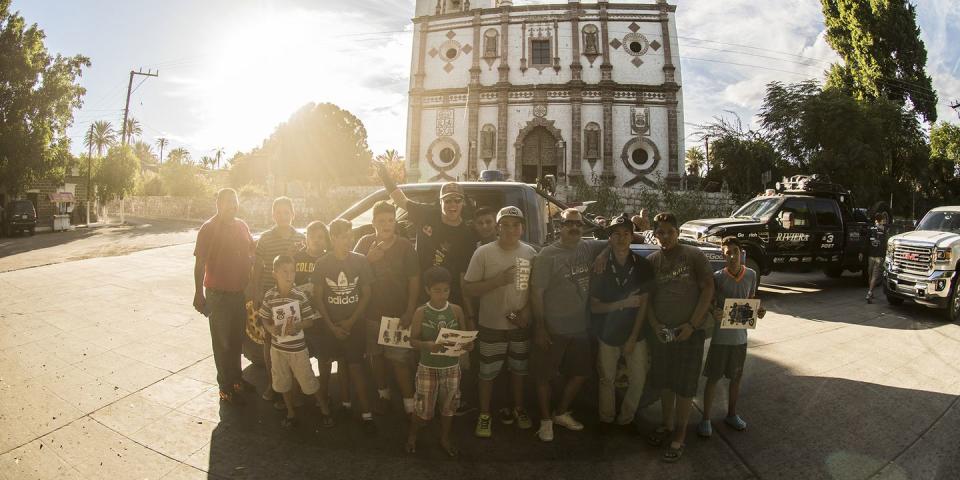
“Everybody has a different interpretation. Airplane, for me, that means clear-over jump, sky it. Two mountains is rolling hills. Red X is rock on right; blue X is rock on left. Yellow X is caution, slow down. This one is danger,” he pointed to a black skull and crossbones, “like, stop, or you’ll run over a f***ing cliff.”
Mortensen worked past midnight. “Waypoint 62” became “Left 4” with a little diver-down symbol. “So now that tells me 45-degree left turn, keep it low and tight around the corner, because there’s rocks or trees on the outside,” he said. Red X, blue X, airplane, yellow X. The map blossomed.
Over the first 200 miles, Mortensen dropped 189 waypoints, which is actually a relatively light haul. Generally speaking, more experienced drivers require fewer notes, since they’re better at spotting hazards, choosing lines on the fly. Menzies has been racing off-road, in buggies and trucks, for nearly a decade. He’s also been working with Mortensen for years.
“Most drivers will call it out to their co-drivers, ‘Hey, rock on right’ or whatever,” Menzies said. “But Pete and I have been doing this so long, he just makes the notes. He anticipates the whole thing. They’re spot-on, totally perfect.”
Mortensen explained: “I can see him twitch the wheel, get unsettled, when his rhythm gets broken. I know what he’s thinking. That’s when I make a note.”
The sections became procedural and took on a hypnotic cadence. Throttle, lift, throttle, lift, throttle, hesitation, note, throttle, lift . . .
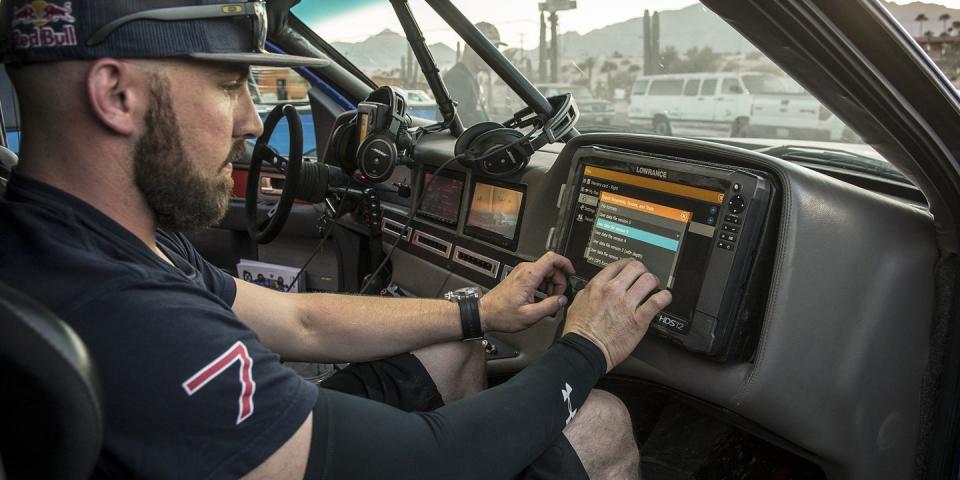
"That's inbounds!"
We were surfing through an expansive sand wash, stretched flat and wide across a valley, flanked by a paved highway on one side and towering, red-rock mountains on the other. A single trail was carved out of the desert brush and scattered rocks. Menzies kept the truck in low gear, leaning hard on the converter, struggling to keep momentum through the ribbon of deep silt. The roaring small-block and roostertail churn would have been pretty dramatic, had we not been going 16 mph. He stared blankly out the side window.
“See something?” Mortensen asked.
“Maybe.”
“This trail is so chewed up already. It’s going to be terrible on race day. Let’s have a look, dude.”
Mortensen rubbed his stomach. He had food poisoning, again, or was still working through the last bout. He wasn’t sure.
“Just don’t slow down too much,” he said. “I really don’t feel like digging us out.”
Menzies made a sharp left and went off the course, slaloming through the scattered boulders and tall bushes. We made our way to the edge of the wash, where a gravel outer road ran parallel to the highway, the two separated by a line of orange construction barrels.
“That’s inbounds!” Mortensen called out.
Menzies wheeled onto the gravel and matted it. Second gear, third. Mortensen jabbed at his touchscreen as we picked up speed, cuing up the New Trail mode on the map; a green line appeared alongside the black SCORE line, tracing our progress. The outer road spanned the entirety of the section between two virtual checkpoints, a neat lip alongside the highway, effectively bypassing the mile-long wash that had been bogging us down.
On race day, the shortcut might save them eight or nine seconds. Most of the other notes will amount to far less. Pre-running is a grind of incremental gains-one second saved here not lifting, another there avoiding a rut-a succession of small advantages, which, taken together, can amount to a large one.
“I hope other people don’t find this,” Menzies said, merging back onto the course. “This is f***ing huge.”
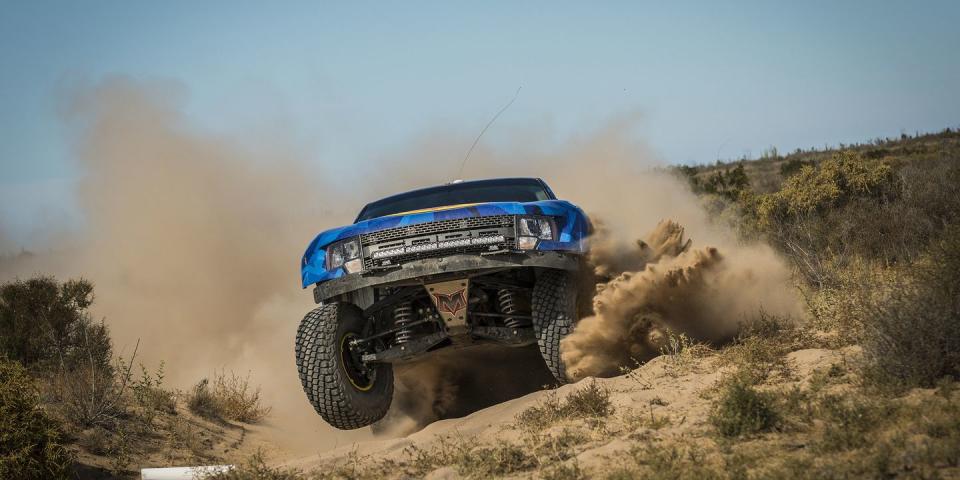
"Getting your buddies together, railing through the desert."
No amount of preparation can control for the realities of Mexican desert racing. This event is simply too long, the elements too unpredictable. Drivers frequently encounter roaming livestock and man-made booby traps. Teams have been robbed at gunpoint. Spectators can be unruly, drinking all day and standing inches from speeding trucks at night. Some years, people get killed.
Two weeks after our pre-run, the Menzies Motorsports crew finished 11th in the race. Half the grid didn’t finish at all. The team held the lead at one point but lost their hood and lights in a high-speed collision when another truck stopped abruptly on the course. Compromised visibility from rain and fog slowed their pace; then the gearbox broke 80 miles outside La Paz, necessitating a two-hour repair.
That doesn’t mean the fastidious pre-run wasn’t worthwhile. Or, in its tedious way, enjoyable. Racing Baja is about defying the natural pace. Pre-running is about indulging it.
“Getting your buddies together, railing through the desert, relaxing with drinks at night. That’s part of the tradition, the culture down here,” Mortensen said. “If they did it like Dakar, where there’s no pre-running, the field at Baja would be cut in half immediately.”
You Might Also Like

 Yahoo Autos
Yahoo Autos 